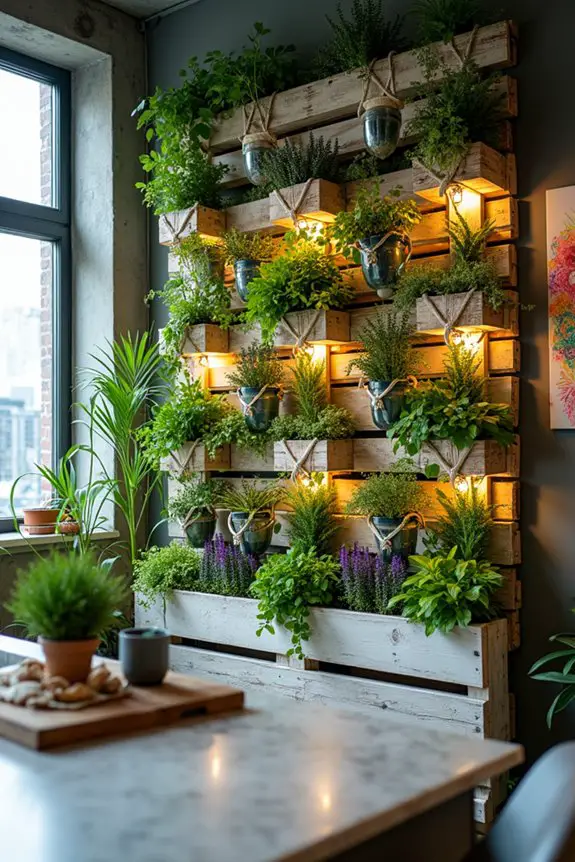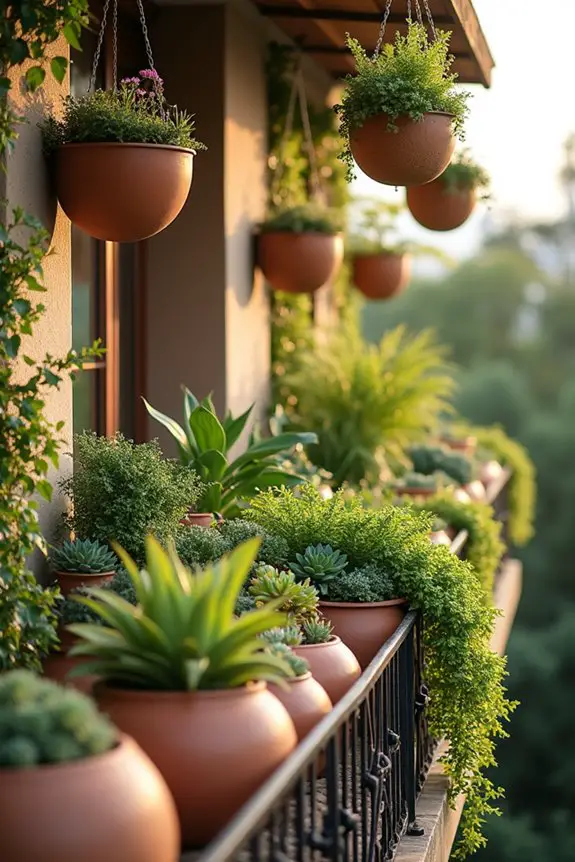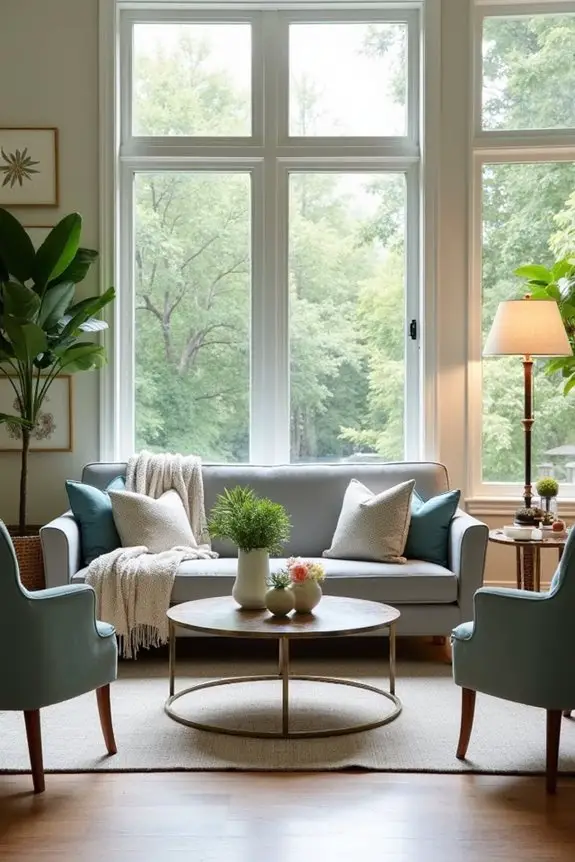Ever wondered if indoor gardens can really transform a space? It’s like bringing a slice of the outdoors right into your home. Imagine this: lush greenery, charming planters, maybe even a sprinkle of fairy lights. Sounds dreamy, right? But how do you pull it off without turning your living room into a jungle? Let’s explore ten inspired indoor garden designs that make your space come alive, leaving you enthusiastic for more details and practical tips.
The Vertical Garden Concepts
Have you ever thought about how cool a vertical garden could look in your space?
Imagine this: hanging planters bursting with greenery, colors that pop, and a clever arrangement that tells a story.
You’ll be amazed at how simple it’s to create a botanical wall art display that transforms any light-filled room into your personal oasis.
1. Hanging Planter Aesthetic
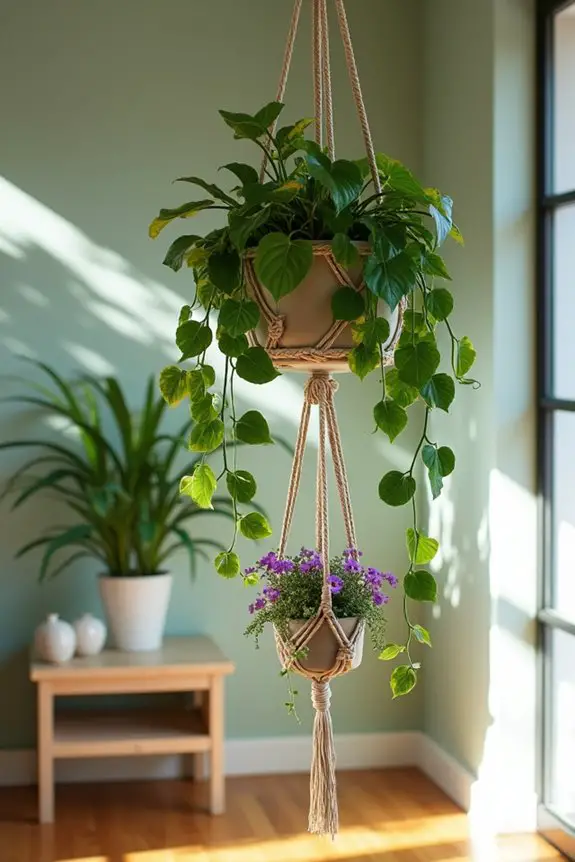
When it comes to indoor gardening, hanging planters can really take your space to a whole new level. They’re not just practical for making the most of your vertical space; hanging planters can turn a plain wall or corner into a vibrant tapestry of greenery.
Plus, who doesn’t want an indoor jungle vibe? It’s like living in a treehouse, minus the fear of the neighbor’s angry cat.
To start, you’ll need to choose your plants wisely. Think trailing vines like pothos or string of pearls. These plants will cascade down beautifully, creating that dreamy, whimsical look. You can mix and match them with some colorful flowers for an eye-popping display. Ceramic watering globes can help maintain the right moisture level for these plants as they thrive in hanging planters.
Just imagine the way those greens and blooms will dance in the light! It’s like your personal version of a botanical art installation.
Next, let’s talk about the planters. You can either go for pre-made ones, which are a safe bet, or craft your own from quirky items like tin cans, baskets, or even old shoes (hey, one person’s trash is another person’s treasure, right?).
Just remember to drill some drainage holes unless you want your precious plants to drown—nobody wants a herbaceous swimming pool, trust me.
Once your planters are ready, it’s all about the setup. You can hang them from walls, ceilings, or even curtain rods. Just make sure they’re secure enough to hold the weight of the soil and plants.
If you have little ones or furry friends running about, you might want to hang them higher up—to keep your plants safe from curious hands and tails.
Now, for the watering routine. A little tip from yours truly: hanging plants can dry out faster than you’d expect. So, check on them more often than you might think is necessary because no one wants a withered, sad-looking plant.
And if you’re like me and possess the well-honed talent of neglecting plants (who knew thyme could stress me out?), make sure you set reminders on your phone. Also, investing in a good pair of harvesting shears garden can make maintaining your plants much easier when it comes time for pruning.
Lastly, step back and take a look at your handiwork. There’s something incredibly satisfying about watching your living art evolve.
You’ll feel like a proud parent—just without the late-night feedings and diaper changes. With a bit of time and creativity, your hanging planter aesthetic can become your favorite indoor escape!
2. Color Palette Coordination
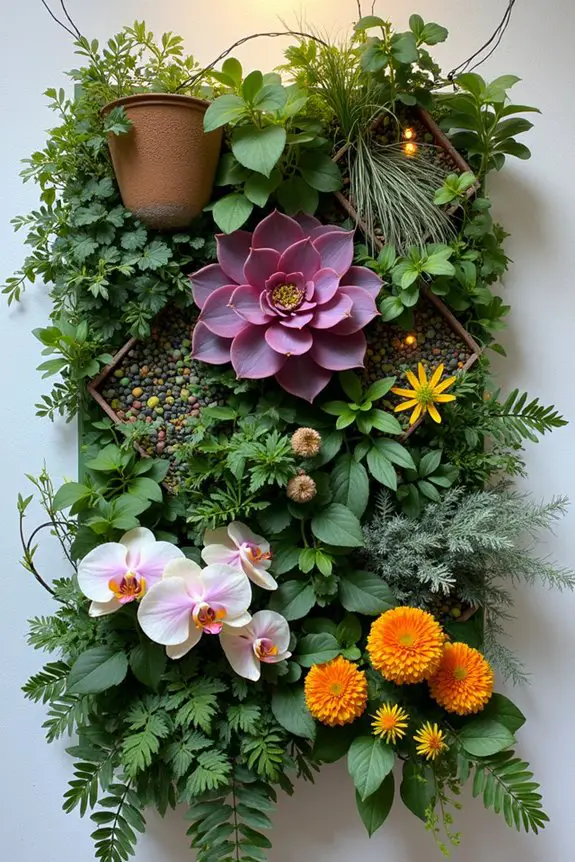
When it comes to creating a stunning vertical garden, color palette coordination is key. It’s not just about throwing a bunch of plants together and hoping for the best; it’s creating a visual journey for your space. Think of your indoor garden as a canvas, and the plants are your colors. The right palette can set a mood, whether you’re going for a calming zen vibe or something vibrant and energetic.
Start by picking a main color theme. Do you want soothing greens and whites that create a fresh, clean look? Or maybe you’re feeling bold and want to mix in some blush pinks or deep purples for extra drama. Remember, contrasting hues can make your arrangements pop while similar shades create a more unified feel. So, if you’ve got some lush ferns, consider placing them next to pastel flowers—it’s like mixing a smoothie with all your favorite flavors. Yum.
Next, keep in mind the texture too. A mix of leafy, spiky, and fluffy plants not only adds depth but also gives a dynamic feel to your vertical garden. Imagine pairing soft, billowing ivy with some sharp-edged succulents. It’s a matchup that speaks to your inner interior designer.
You’ll want to step back and see how the colors and textures dance together, just like performers in a theater.
And don’t forget about seasons. Some plants bear vibrant features in summer but may fade a bit in winter. It might be worth swapping out a few during the colder months to maintain that lively feel. You can also try adding seasonal accessories—like little decorative pots in festive colors—to keep it fresh and fun.
Take this as your opportunity to play and experiment. Spread out your plants on the floor next to your indoor garden space before committing.
It’ll be like a fun jigsaw puzzle, fitting pieces together until you find just the right arrangement. Just try not to get too attached to any one plant—trust me, it makes the rearranging a lot harder when you’re emotionally invested.
With a little creativity and a keen eye for color, your vertical garden will be the envy of your friends and a cozy retreat for yourself. Happy planting!
3. Planter Arrangement Strategies
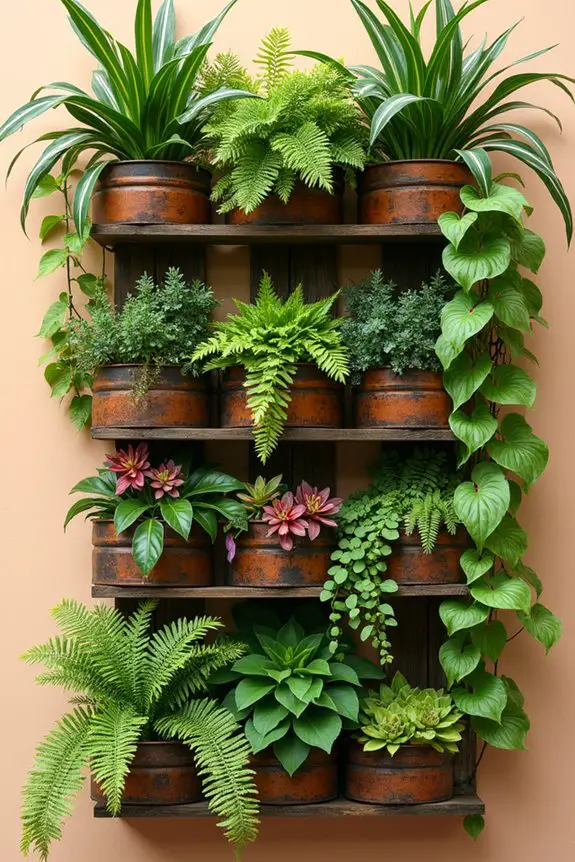
When it comes to arranging your plants in a vertical garden, think of it like creating a beautiful dish. You want balance, flavor, and harmony. Not only does a well-planned arrangement make your space look fantastic, but it also guarantees that each plant gets the attention it deserves. It’s about creating a lush, living tapestry that draws the eye in and makes you feel all warm and cozy.
First off, consider your backdrop. The wall or space you choose to mount your vertical garden acts like a plate for your culinary creation. If you have a neutral or darker background, you can really showcase vibrant greens and bold colors. On the flip side, for a vividly colored wall, you might want to keep your plants softer and more muted so they don’t clash. Imagine how sad it would be if your plants were like guests at a party who just don’t get along—awkward. Adding slow release plant spikes can ensure your plants receive nutrients consistently, keeping them lively and healthy.
Now let’s talk height. Just like layers in a lasagna, mixing tall and short plants adds dimension and makes your garden more interesting. Start by placing taller species—think lovely snake plants or cascading pothos—at the top. This way, they don’t overshadow the smaller, cuter plants below but rather create a visual flow downward. Think of it as a cascading waterfall of greens and colors, beautiful and revitalizing.
Don’t forget about the rules of arrangement! A good rule of thumb is to group plants with similar watering and light needs. It’s like cooking, if you throw everything in the pot without checking the cooking times, you might end up with a weird mush. If your plants have different needs, you may as well be asking your tomatoes to dance alongside your potatoes. They simply won’t agree on the right temperature.
And here’s a playful tip: consider using a variety of planters—different shapes, heights, and textures can add a playful touch. Rustic pots, sleek modern containers, or even recycled tin cans can make your arrangement feel alive. It’s like wearing a quirky pair of socks with your favorite shoes—unexpected but delightful.
Finally, take a step back (like, from the kitchen counter when you’re checking on a bubbling pot) and glance at your vertical garden from different angles. Does it evoke joy? Does it make you smile? If not, don’t stress it; plants are forgiving, and you can always rearrange until you find your perfect fit.
Additionally, be sure to wear proper protection, such as a respirator mask, when handling certain plants to keep your respiratory health safe as you garden.
The journey is just as rewarding as the destination, and each time you tweak it, you’re learning. So, roll up those sleeves, let your creativity flow, and enjoy the delightful dance between plants in your very own vertical garden.
4. Botanical Wall Art Ideas
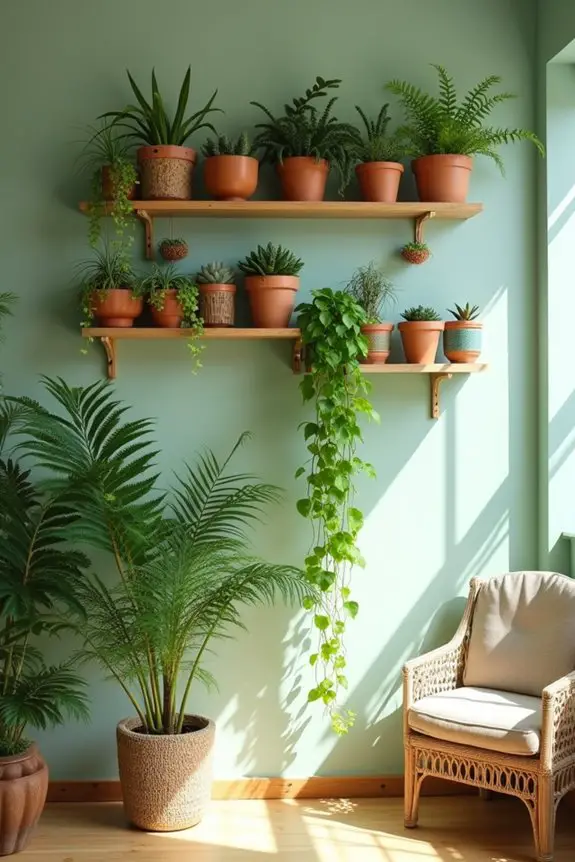
Imagine walking into a room that feels like a breath of clean air, filled with vibrant greens and a sprinkle of personality. That’s exactly what botanical wall art can do for your indoor garden. This idea not only beautifies your space but also serves as a living piece of art that speaks to your style. Embrace the natural elements and watch your walls transform into a lively gallery of plants.
First off, let’s talk about plant selection. Opt for a mix of textures and sizes to create visual interest. Picture lush ferns tucked beside trailing ivy; it’s like a green concert where every plant has its solo. You might even consider using succulents for a pop of variety— they come in all sorts of funky shapes. Just like picking ingredients for a tasty dish, choose what makes your heart sing but remember, variety is the spice of life.
Next up, the arrangement. Imagine your wall as a canvas waiting for a masterpiece. Start by placing larger plants at the base, providing a sturdy foundation—think of it like choosing the perfect crust for your pizza. From there, build upward with smaller plants, creating layers. It’s a bit like stacking your favorite pancakes; each layer should be beautiful but also functional. Just be sure to give plants enough space to breathe—no one wants to feel crowded.
Don’t forget about your containers, either. Different pots can add a whimsical touch, kind of like fancy toppings on a sundae. Go for colorful ceramic pots, rustic wooden containers, or even hanging macramé planters that sway gently, kind of like your grandma’s curtains on a breezy day. It’s all about creating that delightful feel-good vibe.
Lastly, step back every now and then. Look at your botanical wall art from different angles—does it spark joy? Does it feel balanced? Make adjustments as needed, much like seasoning a dish until it’s just right. And if something isn’t working out, don’t worry; plants are pretty forgiving, unlike that lasagna you may have accidentally burned last week.
Remember, this is about the journey of nurturing and creating, so don’t sweat the small stuff.
With these botanical wall art ideas, your vertical garden will truly become a living piece of art—a place where style and nature dance together in harmony. Now, roll up your sleeves, get those hands dirty, and let your inner artist shine.
5. Light-Filled Space Utilization
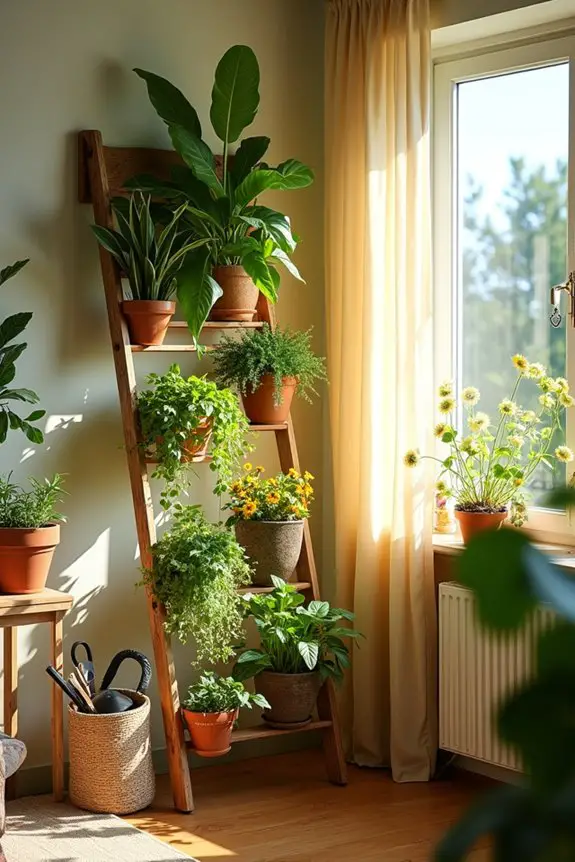
When it comes to indoor gardens, making the most of your light-filled spaces is a game changer. By utilizing vertical gardening concepts, you can transform even the tiniest corners into lush, green retreats. Not only does this approach maximize your space, but it also creates an inviting atmosphere that feels invigorating and lively, like opening a window on a warm spring day.
So, how do you go about it? Start by scouting your space for the sunniest spots—these are like golden nuggets waiting to be discovered. Think about using wall-mounted planters or shelves that allow your plants to enjoy the light without crowding your floor.
Just like layering a sandwich, keep the arrangement organized: place shorter plants at lower levels and taller ones up high to create an eye-catching display—no one wants a towering tomato plant blocking the beautiful view of a cascading pothos, right?
And speaking of selection, don’t shy away from experimenting! Mix and match leafy greens with flowering plants, or go for herbs that add both beauty and utility—who wouldn’t love to snag a sprig of basil when cooking up spaghetti?
Ponder using trellises to add depth and dimension; they’re like the secret weapon of indoor gardeners. You could even use fun, upcycled materials, like old wooden crates or metal ladders, to give off that charming eclectic vibe.
Remember to reflect on your watering routine too, as vertical gardens can sometimes forget their residents at the top. Use drip irrigation if you can; it’s like giving your plants an invigorating spa day while you mind your business. Additionally, consider labeling your plants with stylish plant labels to keep track of your diverse collection.
And let’s be real, if you’ve ever tried to climb on a chair to reach a thirsty fern, you know how tricky plant care can get—even for the most determined of us.
6. Seasonal Plant Rotation Techniques
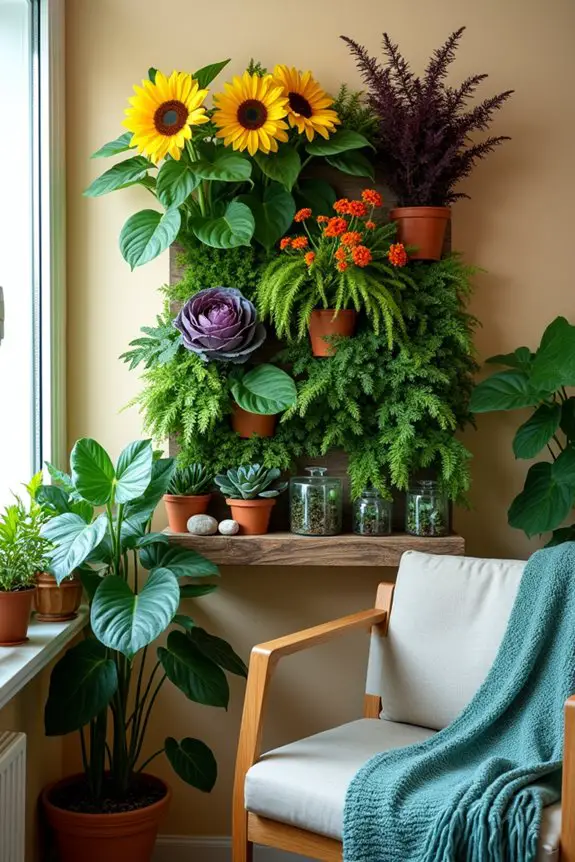
When you’re kicking off an indoor garden, seasonal plant rotation is a real gem. It not only keeps your space fresh and interesting, but it also helps your plants thrive. Think of it like switching out your wardrobe for the seasons—who wants to wear the same thing all year long?
By changing up your plant lineup, you’re ensuring you’re utilizing the right plants for the right time, creating a vibrant, cozy atmosphere that welcomes the changing seasons.
So, how do you get started? First, make a list of the plants you love and their growing seasons. You’ll want to think about how some plants flourish in the warm summer sun, while others prefer the cooler air of fall or winter.
For instance, you can swap out those cheerful sunflowers—wonderful for summer—when the crisp air hits and bring in some hearty ferns or ornamental cabbages instead. Sounds simple, right? It is.
If you’re feeling adventurous, try grouping your plants by their water and light needs. This way, when you do your seasonal switcheroo, you can grab a whole set that’s ready to thrive together.
Picture it like getting your favorite snacks for a movie night—the better the mix, the more exciting the experience. Just remember to jot down notes as you rotate; you don’t want to end up with a basil plant that’s turned into a wilting green mush from being moved to the back of the shelf. That’s a real mood killer.
Don’t stress about being perfect. Think I know what I’m doing? I’d be lying if I didn’t admit I’ve accidentally drowned a poor plant in the past.
Yes, I’d a beautiful mint that turned into a soggy disaster because I forgot about it while daydreaming. But hey, it’s all part of the journey!
Keep it fun, be patient with yourself and your plants, and soon enough, you’ll have mastered your seasonal rotations with ease.
And just like that, you’ll be the indoor gardening guru your friends will envy.
7. DIY Planter Box Customization
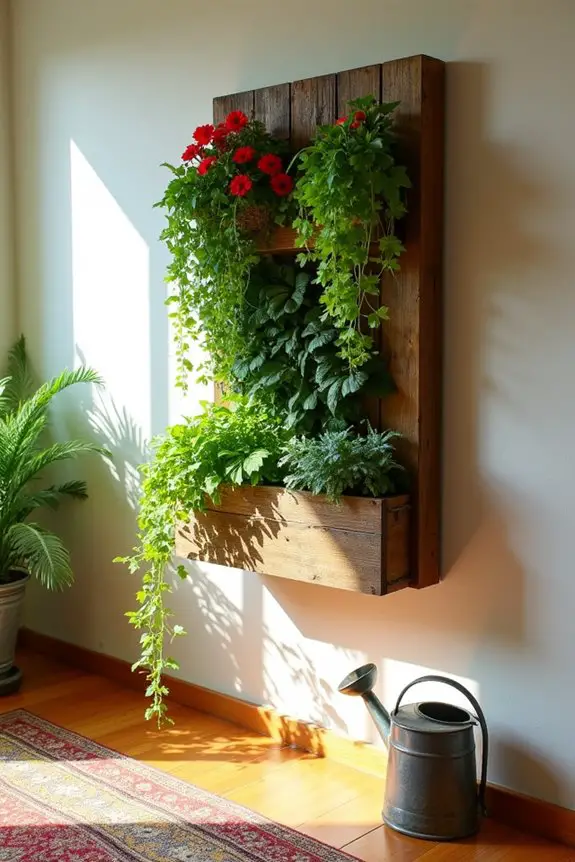
Creating your own DIY planter box for a vertical garden is a game changer. Not only does it save space, but it can also add a unique touch to your indoor oasis. Think about it, how cool is it to have greenery climbing up your walls or cascading down in beautiful layers? It’s like nature’s own art installation right in your living room.
Plus, they’re flexible enough to fit into any style, whether you prefer a rustic vibe or a sleek and modern look.
So, how do you bring your vertical garden dreams to life? Start with choosing your materials. You can get creative with wood pallets, old crates, or even repurposed wooden boxes. Just make certain they’re sturdy enough to hold your plants and soil.
I once used an old bookshelf as a vertical planter—it looked great, but let’s just say I had a minor “soil avalanche” when trying to move it… more on that later.
Once you have your structure, cut it to the size you need. If you’re going for pockets of plants, space them out accordingly so your plants have room to breathe, just like your favorite pair of jeans after Thanksgiving dinner.
Drill drainage holes in the bottom, because nobody wants soggy plant roots—trust me, those little guys can get pretty cranky.
Next, layer your planter with landscaping fabric to keep the soil in place while allowing water to drain. Fill it up with potting soil—extra points if you mix in some compost for that nutrient boost. Then, comes the fun part: planting! Opt for a variety of herbs, flowers, or even small veggies.
Think of the possibilities—imagine plucking fresh basil for your pasta dishes or colorful snapdragons adding a pop of joy to your space.
And here’s a tip: if you really want to put the ‘wow’ in your vertical garden, think about using trailing plants on the bottom layer. They’ll drape down beautifully and give the illusion of a lush waterfall.
Just be careful while watering; I’ve had my fair share of accidental plant showers—water everywhere and a cranky cat making sure I know it wasn’t her cup of tea.
Safety first: verify your planter is securely mounted to the wall to prevent any green-thumbing disasters.
Once it’s all set up, step back and admire your handiwork. You’ve just transformed a bare wall into a breathtaking vertical garden—with your own flair sewn into every plank. Happy planting!
8. Eco-Friendly Materials Selection
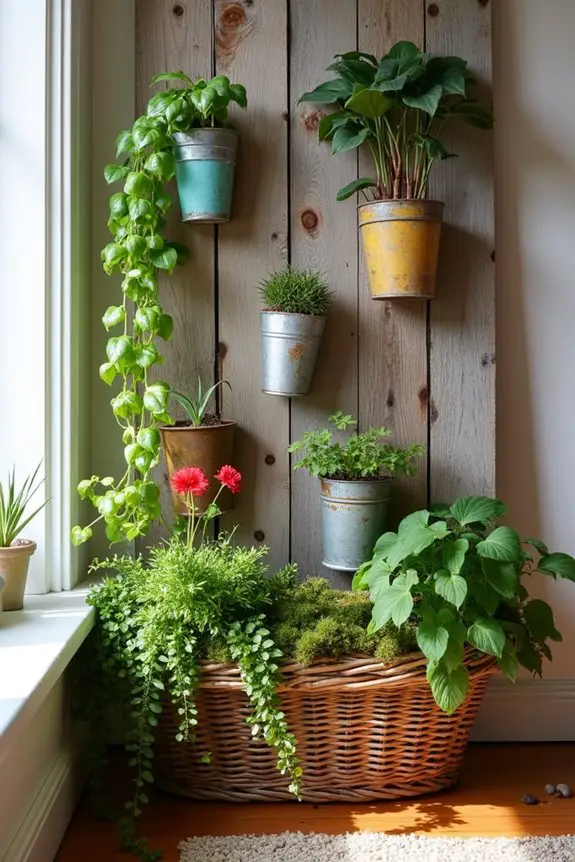
When it comes to vertical gardens, the materials you choose can make all the difference. Not only do eco-friendly materials help our planet, but they can also bring a fresh, earthy vibe to your space. Think about it: reclaimed wood, repurposed pallets, or even upcycled metal containers provide more than just a practical structure for your plants. They add character and a story to your indoor jungle, creating an atmosphere that’s both stylish and sustainable.
First off, let’s talk about wood. Reclaimed wood is a great choice since it has a lovely weathered charm that brings in warmth and organic texture. You can often find it at local salvage yards, and sometimes you can even steal a couple of planks from a neighbor’s fence if they’re not watching—kidding, of course. Just confirm it’s safe for your plants and free of chemicals. You want your herbs thriving, not discussing existential crises caused by treated lumber.
Next, consider using recycled plastic planters. They’re lightweight, durable, and come in various colors and styles. Plus, opting for these helps cut down on plastic waste in the environment. Just make certain your planter has proper drainage—no one likes soggy, sad plants; it’s like letting your pizza get cold before eating it, just plain wrong.
Then there are metal containers. Think old tin cans or even rusted buckets. They give a funky, vintage look, and if you’re like me, you definitely have a stash of random containers somewhere. Just drill a few holes for drainage, and you’ve got yourself a chic home for your herbs or blooms. I once had a sunflower sprout from an old cookie tin—eating those cookies must have been worth it, right?
Lastly, consider biodegradable options for your planting medium. Peat-free soil mixes are kinder to the environment and do wonders for your plants. They hold moisture beautifully, like a good pair of sweatpants hugs your waist after Thanksgiving. Mix in some compost—your plants will thank you for that nutrient boost!
9. Biophilic Element Integration
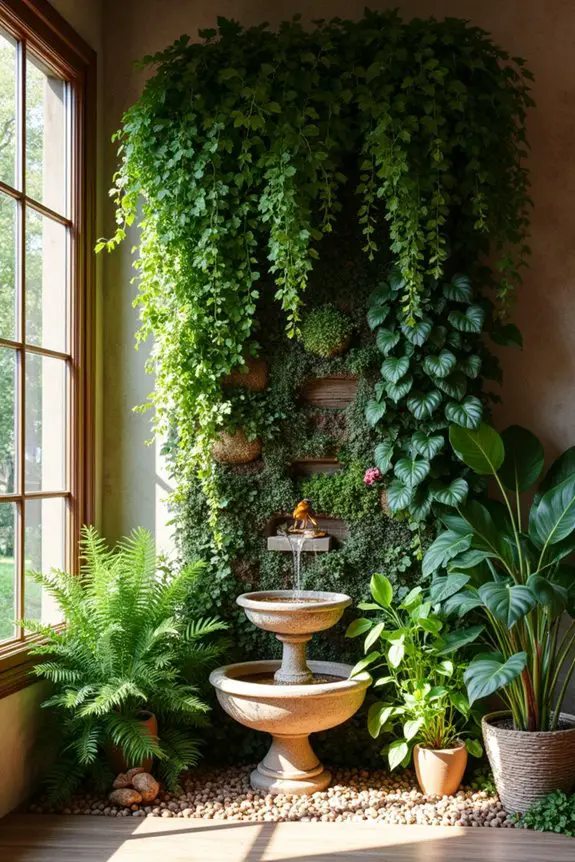
When you think about bringing nature indoors, connecting with the elements helps create a serene, inviting atmosphere. That’s where biophilic design comes in—a fancy way of saying that nature makes us feel good and can be woven right into your vertical gardens. It’s not just about aesthetics; it’s about creating an indoor environment that supports overall well-being. The sound of leaves rustling or the fresh smell of herbs can make your space feel alive and vibrant, like inviting the great outdoors in—without the bugs.
Start with different plant types to add depth. Mix heights and textures. For instance, cascading ivy at the top, with vibrant ferns below, creates a tiered effect reminiscent of a forest floor. Imagine sipping your morning coffee in the company of trailing vines resembling a lush jungle. Talk about dreams coming true—or at least a mini-vacation for your senses.
But wait, there’s more! Consider integrating features like small water elements such as a mini fountain or a simple birdbath. The soothing sound of trickling water can be a stress-relief magnet. It’s like giving an audio treat to your whole space. Plus, you’ll have birds popping over, adding a bit of cheerful chaos to your cozy corner. Who doesn’t want a secret bird club gathering in their living room?
And don’t forget to play with natural light. Orient your vertical garden to soak up those golden rays. Sunlight filtering through your plants can create mesmerizing shadows and patterns on the walls—nature’s very own art exhibit. It’s stunning and creates a grounded feeling, connecting you with the rhythms of nature.
10. Sustainable Urban Gardening Aesthetics
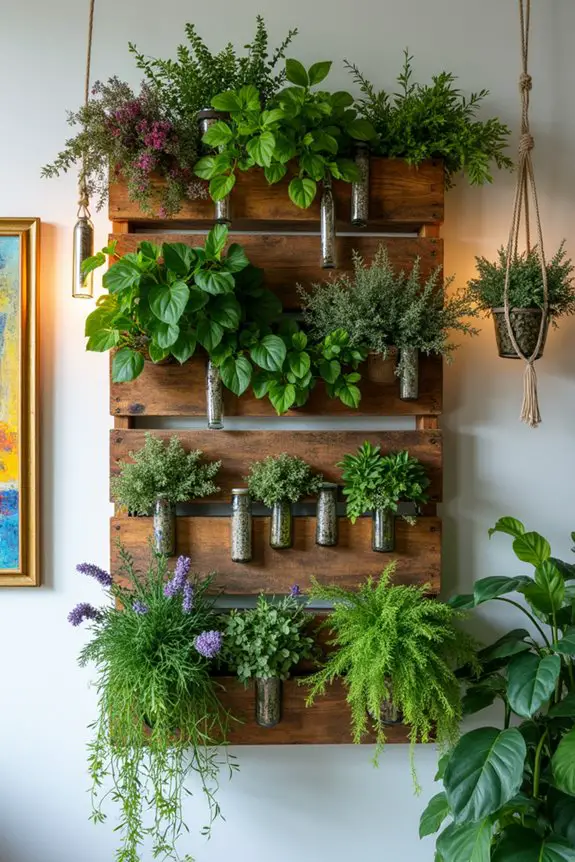
When it comes to creating an indoor vertical garden, the concept of sustainable urban gardening aesthetics really shines. Not only does it maximize your space, making your home greener and fresher, but it also adds a trendy vibe that just takes your decor to another level. Imagine walking into a room adorned with vibrant greens, a lovely reminder of nature amidst the urban hustle and bustle.
To start, think about using recycled materials for your vertical garden frame. You know, like those old wooden pallets lingering in the garage, or even those empty soda bottles. Give them a good clean and transform them into planters! You’ll feel like a DIY hero, and the planet will thank you. A hanging bottle garden isn’t only quirky and unique; it also uses space efficiently, allowing you to grow herbs or flowers right in the kitchen window. Why not have fresh basil for your tomato sauce just a reach away? Talk about a win-win.
Next, mix and match your plant choices. Select low-maintenance varieties like succulents, or if you’re feeling ambitious, you could try your hand at some fragrant herbs. You know how rosemary can make your roast chicken taste gourmet? Picture that thriving in your urban oasis. Aim to group plants that have similar light and water needs—trust me, you’re not trying to become a full-time gardener here. It’s like assembling that perfect plate at a buffet; balance is everything.
Also, don’t shy away from adding some artwork. A few hanging macrame plant holders can add a bohemian flair while being functional. They’ll sway gently, adding movement and interest to the space. Maybe even hang a colorful piece of art nearby for contrast. It’s a bit of an unexpected combination, like pairing your favorite sneakers with a classy outfit — it just works.
Lighting plays a huge role, too. If you don’t have good natural light, consider getting some grow lights. They’re like magic for plants: turning your indoor jungle dream into reality, all while making you feel like a plant parent superstar.
Besides, watching plants thrive with a little help from technology is strangely satisfying, isn’t it? Almost like watching your own miniature ecosystem flourish.
Essential Plant Care Practices
Caring for your indoor plants can feel like a mix of science and art, right? You want to keep those greens thriving, not plotting a tiny revolt.
First, let’s chat about light—most indoor plants love bright, indirect sunlight. It’s like their version of a sweet vacation.
Don’t forget watering; too much and you’re running a plant swim meet. Too little? Well, they’ll sulk in dry corners.
As for humidity, you might want to mist them, especially if you live in a desert-like apartment.
Fertilizing? That’s a magic potion. Use it during the growing season to boost your indoor garden ideas.
And remember, always check for pests. A little inspection goes a long way in keeping your leafy friends happy and healthy.

